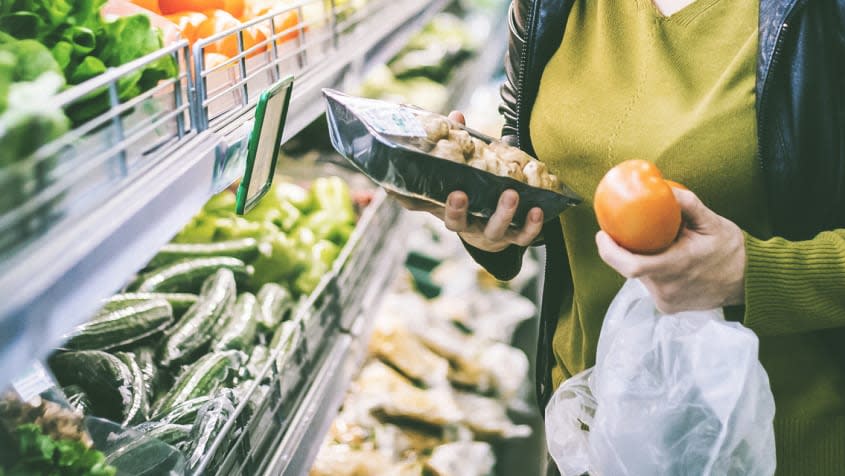Food prices are going up. Here's how you can save.

Grocery prices are once again on the rise. The cost of food briefly declined after going up by an "average of 1% a month in the year through last September," but in July, they jumped once again with an increase of 0.3%, The Wall Street Journal reported. And now, it's possible they could continue to push higher, due to "several factors, including inflation, labor costs, the supply chain and the war in Ukraine," per Nerdwallet.
Given that food prices have yet to fully come down from last year's peaks, these increases could feel like a further squeeze on an already tight budget. Luckily, there are moves you can make on your next trip to the grocery store to keep your tab from edging up any more than it has to.
1. Go in with a plan
Creating a meal plan and a corresponding shopping list before you go to the store can help you purchase more efficiently. During this process, "take inventory of your pantry, refrigerator and freezer to see what ingredients you already have and which may expire soon," NBC Select recommended, which can help you to avoid unnecessary waste and duplicate purchasing. Another tip is to try planning some meals around what's on sale. There are apps like Flipp or My Grocery Deals that "allow you to compare prices at home without having to sift through paper circulars," per Forbes.
When you apply via our links, we may earn an affiliate commission.
2. Limit distractions and temptations
Once you get to the store, be serious about sticking to the list you've made. According to Nerdwallet, you may "consider shopping alone so you can get in and out quickly, without kids lobbying for items not on the list or in your budget." Another way to curb impulse purchases is to "limit your trips to the store," as that means "the fewer opportunities you have for impulse purchases," according to Nerdwallet.
3. Join loyalty programs
You can also enjoy savings if you sign up for the loyalty programs at grocery stores you frequent. As Bankrate reported, "Plenty of groceries have loyalty programs you can sign up for that will earn you points and send you coupons, often integrated into the store's app." This also saves you the hassle of clipping out physical coupons, and the app may "tailor your coupon offers to products you've previously purchased," per Forbes. Plus, sometimes stores offer exclusive discounts just to their loyalty members.
4. Opt for generic over name brands
If you're willing to get over brand loyalties, you could open up the door to savings. As Bankrate stated, "brand-name products are more expensive than their generic counterparts," and even if "saving an extra $2 or $3 may not seem like much, saving a few extra bucks on 20 items can add up." Further, Bankrate reported that there might not be as big of a difference between generic and name-brand as you might think, noting that "many generic products are manufactured in the same facilities as your favorite name-brand products. And some generic products are "exactly the same as name-brands but with a smaller price tag."
5. Get creative and stay open to substitutions
According to NPR, "some ingredients are more expensive than others," meaning that another way to save at the grocery store is to "cut back on those or find substitutes." As an example, NPR suggested that "if a chili recipe calls for a pound of ground beef … you could reduce the beef by half and then bulk up the recipe with less expensive ingredients like beans, lentils or rice." This also brings up the cost-saving helpfulness of creativity in the kitchen, such as brainstorming fresh ways to use leftover ingredients or using one ingredient in a few different recipes.
6. Stick to the perimeter when shopping
Another tip for saving is to stick to the outer edges of the grocery store while shopping and avoid the center aisles as much as possible. According to Bankrate, "The aisles in the center of the supermarket contain processed foods, which tend to be pricey, whereas the outer walls are where you'll often find things like fruits, vegetables and other unprocessed foods that can be more cost-effective." The bonus of this shopping tactic is that you'll generally end up bringing home healthier foods.
7. Buy in bulk
Especially if you're shopping for several people, another smart way to save is by buying in bulk. You might do this by joining a wholesale club like Costco or Sam's Club or stocking up when an item you often use is on sale. Another suggestion from Bankrate is to "buy in large quantities and freeze what you don't need right now" since certain foods are "significantly cheaper when purchased in bulk." Just remember this tactic will involve spending more upfront, even if you will end up saving in the long run.
8. Pay with a rewards credit card
According to NBC Select, "Using a credit card to pay for your groceries may be beneficial, depending on which one you have." There are several credit cards available that will offer cash-back or other rewards on your spending, so you're getting a little bit of the money you spent at the grocery store back in your pocket. With this tactic, however, you'll need to be mindful of any annual fees and interest charges. Per Nerdwallet, you'll want to aim to "pay the card off in full each month rather than carrying a balance," or else "interest charges may eat up your savings."
Becca Stanek has worked as an editor and writer in the personal finance space since 2017. She has previously served as the managing editor for investing and savings content at LendingTree, an editor at SmartAsset and a staff writer for The Week.

